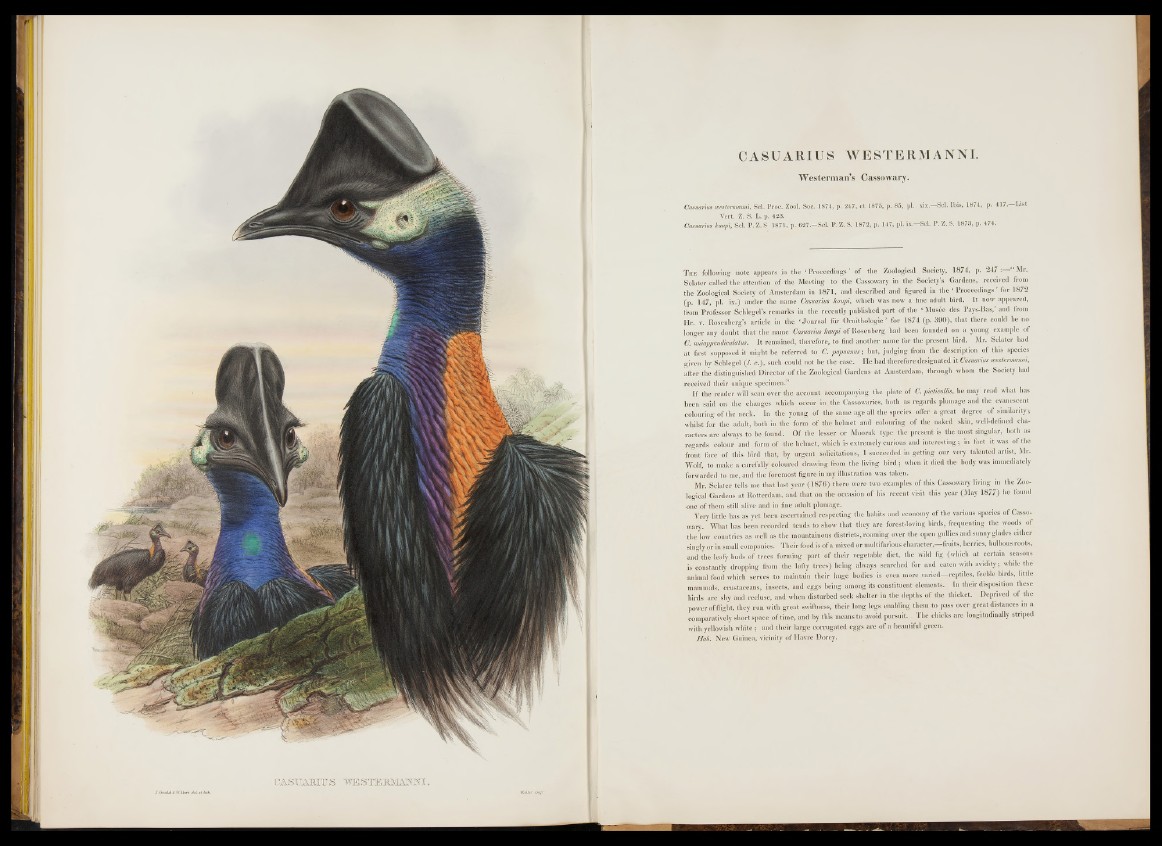
CASUMHUS "WESTEBMANHl,
J.Gould/JcVTJiart dcl.et litii.
CASUARIUS WE8TERMANNI.
Westerman’s Cassowary.
Casuarius westermanni, Scl. Proc. Zool. So.c. 1874, p. 247, et 1875, p. 85, pi. xix. Scl. Ibis, 1874, p. 417. List
Vert. Z. S. L. p. 423.
Casuarius Ttaupi, Scl. P. Z. S 1871, p. 627 -S c l. P. Z. S. 1872, p. 147, pi. ix.—Scl. P. Z. S. 1873, p. 474.
T he following note appears in the ‘ Pro ceed in g s’ of the Zoological . Society, 1874, p. 2 4 7 : Mr.
Sclater called the attention o f the Meeting to the Cassowary in the Society’s Gardens, received from
the Zoological Society o f Amsterdam in 1871, and described and figured in the ‘ Pro ceed in g s’ for 1872
(p. 147, pi. ix.) under the name Casuarius Jcaupi, which was now a fine adult bird. I t now appeared,
from Professor Schlegel’s remarks in the recently published p art o f the ‘ Musée des Pays-Bas,’ and from
H r. v. Rosenberg’s article in the ‘ Journal fiir Ornithologie’ for 1874 (p. 3 9 0 ), th at there could be no
longer any doubt th a t the name Casuarius kaupi o f Rosenberg had been founded on a young example of
C. uniappendiculalus. I t remained, therefore, to find another name for the present bird. Mr. Sclater had
at first supposed it might be referred to C. papuanus ; but, judging from the description o f this species
given by Schlegel (/. c .), such could not be the case. He had therefore designated it Casuarius westermanni,
after the distinguished Director o f the Zoological Gardens a t Amsterdam, through whom the Society had
received their unique specimen.”
I f th e're ad e r will scan over the account accompanying the plate o f C. picticollis, he may read what has
been said on the changes which occur in the Cassowaries, both as regards plumage and the evanescent
colouring o f the neck. In the young o f the same age all the species otter a great degree o f similarity ;
whilst for the adult, both in the form o f the helmet and colouring of the naked skin, well-defined characters
are always to be found. O f the lesser o r Mooruk type the present is the most singular, both as
regards colour and form of the helmet, which is extremely curious and interesting ; in fact it was of the
front face o f this bird that, by urgent solicitations, I succeeded in getting our very talented artist, Mr.
Wolf, to make a carefully coloured drawing from the living b ird ; when it died the body was immediately
forwarded to me, and the foremost figure in my illustration was taken.
Mr. Sclhtêr tells me th at last year (1 8 7 6 ) there were two examples o f this Cassowary living in the Zoological
Gardens at Rotterdam, and th at on the occasion o f his recent visit this year (May 1877) he found
one o f them still alive and in fine adult plumage.
Very little has às yet been ascertained respecting the habits and economy o f the various species o f Cassowary.
Wh at has been recorded tends to show th at they are forest-loving birds, frequenting the woods of
the low countries as well as the mountainous districts, roaming over the open gullies and sunny glades either
singly or in small companies. Th eir food is o f a mixed or m ultifarious c h a ra c te r^ jfru its, berries, bulbous roots,
and the leafy buds o f trees, forming p a rt of their vegetable diet, the wild fig (which a t certain seasons
is constantly dropping from the lofty trees) being always searched for and eaten with avidity; while the
animal food which serves to maintain their huge bodies is even more varied— reptiles, feeble birds, little
mammals, crustaceans, insects, and eggs being among its constituent elements. In their disposition these
birds are shy and recluse, and when disturbed seek shelter in the depths o f the thicket. Deprived o f the
power of flight, they run with great swiftness, their long legs enabling them to pass over great distances in a
comparatively short space o f time, and by this means to avoid pursuit. . The chicks are longitudinally striped
with yellowish white ; and th eir large corrugated eggs are o f a beautiful green.
Hob. New Guinea, vicinity o f Havre Dorey.